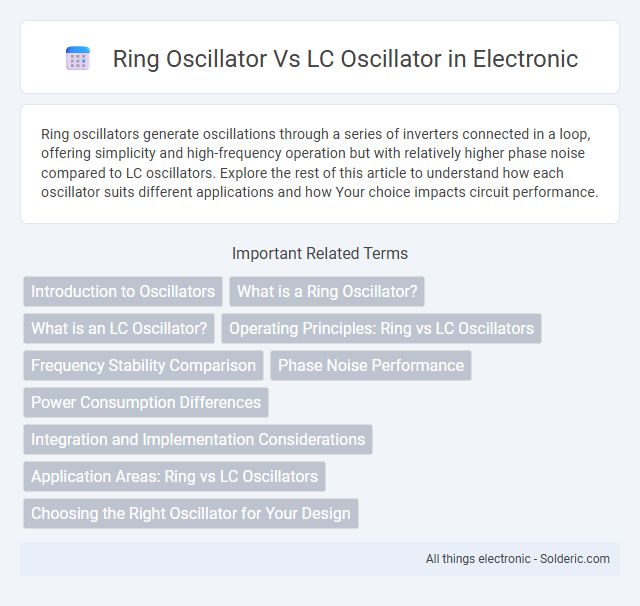Ring oscillators generate oscillations through a series of inverters connected in a loop, offering simplicity and high-frequency operation but with relatively higher phase noise compared to LC oscillators. Explore the rest of this article to understand how each oscillator suits different applications and how Your choice impacts circuit performance.
Comparison Table
| Feature | Ring Oscillator | LC Oscillator |
|---|---|---|
| Basic Principle | Delay stages in a ring form a feedback loop | LC tank circuit resonance using inductor (L) and capacitor (C) |
| Frequency Range | Low MHz to GHz (adjusted by number of stages) | High stability GHz range (depends on L and C values) |
| Frequency Stability | Low stability, sensitive to temperature and supply variations | High stability due to resonant LC circuit |
| Phase Noise | Higher phase noise | Lower phase noise |
| Power Consumption | Low to moderate | Moderate to high |
| Chip Area | Small area, easily integrated in CMOS | Larger area due to inductors and capacitors |
| Application | Delay measurement, on-chip clock generation, test circuits | RF circuits, communication systems, stable clock sources |
| Tuning Method | Changing number of inverter stages or supply voltage | Varactor diodes or variable inductors/capacitors |
Introduction to Oscillators
Ring oscillators consist of an odd number of inverters connected in a loop, generating oscillations through the inherent delay of each inverter stage. LC oscillators use inductors (L) and capacitors (C) to create a resonant circuit that produces a stable sine wave frequency. Ring oscillators are preferred in digital circuits for their compact size and easy integration, while LC oscillators excel in analog applications requiring high frequency stability and low phase noise.
What is a Ring Oscillator?
A ring oscillator is a type of electronic oscillator consisting of an odd number of inverters connected in a feedback loop, producing a periodic oscillating signal without requiring inductors or capacitors. Its oscillation frequency depends primarily on the number of stages and the propagation delay of each inverter, making it highly suitable for integrated circuit testing and delay measurement. You can utilize a ring oscillator in scenarios where simplicity, small size, and fast startup times are critical, though it generally offers lower frequency stability compared to LC oscillators.
What is an LC Oscillator?
An LC oscillator is an electronic circuit that generates oscillations using an inductor (L) and a capacitor (C) to create a resonant tank circuit. The frequency of oscillation is primarily determined by the inductance and capacitance values, following the formula f = 1/(2p(LC)). LC oscillators are known for producing low phase noise signals and are widely used in radio frequency (RF) applications, unlike ring oscillators that rely on delay stages and generally exhibit higher phase noise.
Operating Principles: Ring vs LC Oscillators
Ring oscillators operate based on a chain of inverters connected in a loop, where the signal propagates through each stage, creating oscillations determined by the total delay of the inverter stages. LC oscillators rely on the resonance between an inductor (L) and a capacitor (C) to generate a sinusoidal output at a frequency defined by the LC tank circuit. For your design, understanding that ring oscillators offer faster startup times and simpler integration, while LC oscillators provide higher frequency stability and lower phase noise, is crucial.
Frequency Stability Comparison
Ring oscillators exhibit lower frequency stability compared to LC oscillators due to their reliance on delay stages, which are sensitive to temperature and supply voltage variations. LC oscillators offer superior frequency stability by utilizing inductors and capacitors to create a resonant tank circuit that maintains a more constant oscillation frequency. If your application demands precise and stable frequency performance, an LC oscillator is generally the preferred choice.
Phase Noise Performance
Ring oscillators exhibit higher phase noise due to their reliance on digital inversion stages, which generate significant jitter and frequency instability. LC oscillators use inductors and capacitors to create a high-Q resonant tank, resulting in lower phase noise and better frequency stability. The high quality factor (Q-factor) of LC tanks directly correlates with reduced phase noise, making LC oscillators preferable for low-noise RF applications.
Power Consumption Differences
Ring oscillators typically consume more power than LC oscillators due to their reliance on a chain of inverters that continuously switch states, causing higher dynamic power dissipation. LC oscillators, leveraging inductors and capacitors, achieve oscillation with lower current flow, resulting in significantly reduced power consumption and higher efficiency. Your choice between these oscillators should consider power budget constraints, with LC oscillators favored in low-power and high-frequency applications.
Integration and Implementation Considerations
Ring oscillators offer easier integration in CMOS processes due to their simple transistor-based inverter stages, enabling compact on-chip layout and low manufacturing costs. LC oscillators require inductors that are challenging to integrate on-chip because of their bulky size and lower quality factors, often necessitating off-chip components or advanced fabrication techniques. Design trade-offs include ring oscillators' higher phase noise and frequency variability versus LC oscillators' superior frequency stability but more complex integration requirements.
Application Areas: Ring vs LC Oscillators
Ring oscillators are widely used in integrated circuits for timing generation, clock recovery, and frequency synthesis due to their compact size and ease of integration. LC oscillators find extensive application in high-frequency circuits, such as RF transmitters, local oscillators in communication systems, and precision frequency sources, offering superior frequency stability and low phase noise. The choice between ring and LC oscillators depends on the required frequency range, phase noise performance, and integration constraints in the target application.
Choosing the Right Oscillator for Your Design
Ring oscillators offer simplicity, small area, and wide frequency range, making them suitable for digital circuits and on-chip applications. LC oscillators provide higher stability, lower phase noise, and better frequency accuracy, ideal for RF communication and precision timing. Your design choice depends on requirements for frequency stability, power consumption, and integration constraints.
Ring oscillator vs LC oscillator Infographic

 solderic.com
solderic.com